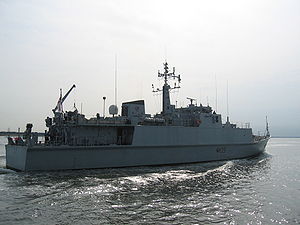HMS Bangor (M109)
 HMS Bangor sweeping Southampton Water in preparation for the International Fleet Review 2005.
| |
| History | |
|---|---|
| Name | HMS Bangor |
| Namesake | Bangor, County Down |
| Operator | Royal Navy |
| Builder | Vosper Thornycroft |
| Launched | 16 April 1999 |
| Commissioned | 26 July 2000 |
| Homeport | HMNB Clyde |
| Identification | |
| Status | in active service |
| General characteristics | |
| Class and type | Sandown-class minehunter |
| Displacement | 600 t (590 long tons; 660 short tons)[1] |
| Length | 52.5 m (172 ft 3 in) |
| Beam | 10.9 m (35 ft 9 in) |
| Draught | 2.3 m (7 ft 7 in) |
| Propulsion | Paxman Valenta 6RP200E diesels 1523 shp, diesel-electric drive, Voith Schneider Propellers, Schottel bow thrusters |
| Speed | 13 kn (24 km/h; 15 mph) |
| Complement | 34 (accommodation for up to 40) |
| Sensors and processing systems |
|
| Electronic warfare & decoys |
|
| Armament |
|
HMS Bangor is a Sandown-class minehunter commissioned by the Royal Navy in 1999. Designed to hunt mines in depths of up to 200 m using the Sonar 2093 Variable Depth Sonar (VDS) meaning that she can conduct mine clearance operations throughout the continental shelf. She is named after the Northern Ireland seaside town of the same name, and the second Royal Navy vessel to bear the name.
History[]
Through October 2011 Bangor conducted maritime security patrols off Misrata during the NATO military intervention in Libya.[2]
Bangor participated in the 2013 Exercise Joint Warrior.[3] She was stationed on the River Clyde for the 2014 Commonwealth Games in Glasgow. For the duration of the games the general public were allowed on board for a free tour.[4]
In mid-2021, Bangor deployed with HMS Middleton to join the vessels of 9 Mine Countermeasures Squadron operating out of HMS Jufair in Bahrain. Both vessels were upgraded with the Oceanographic Reconnaissance Combat Architecture (ORCA) system which assists vessels with a higher level of mine detection at greater stand-off distances. Bangor and Middleton were to relieve their sister vessels HMS Brocklesby and HMS Shoreham, which were to return to the U.K..[5]
References[]
- ^ "Sandown Class Mine Countermeasures Vessels - Specifications". GlobalSecurity.org. 11 July 2011. Retrieved 8 June 2014.
- ^ "UK operations over Libya continue". Ministry of Defence. 14 October 2011. Archived from the original on 26 October 2012. Retrieved 17 March 2019.
- ^ "Scotland set to host Exercise Joint Warrior". Royal Navy. 2 October 2013. Archived from the original on 9 October 2013. Retrieved 17 March 2019.
- ^ Ferguson, Brian (16 May 2014). "Royal Navy to stage Glasgow 2014 show on Clyde". The Scotsman. Retrieved 17 March 2019.
- ^ "UK minehunter joins operations in region".
External links[]
| Wikimedia Commons has media related to IMO 4906783. |
"HMS Bangor". Royal Navy.
- Sandown-class minehunters
- Ships built in Southampton
- 1999 ships
- Minehunters of the United Kingdom
- United Kingdom minesweeper stubs